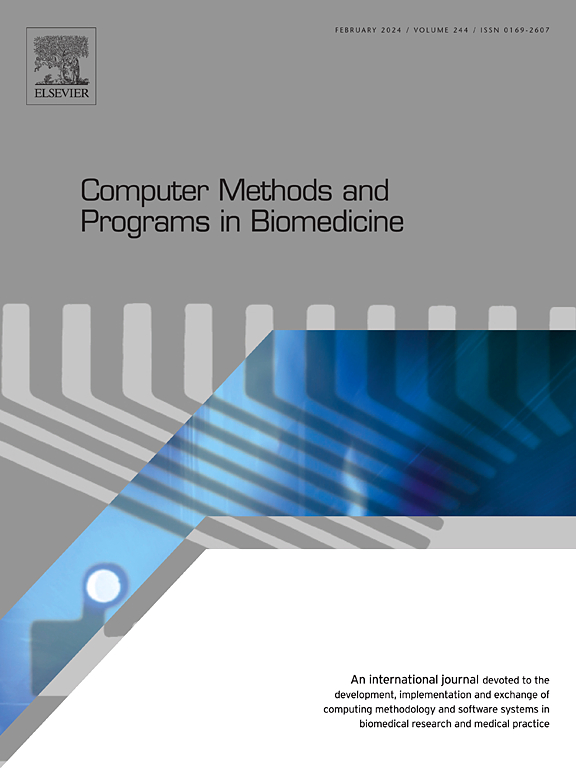Uncertainty quantification for simulating coronary artery hemodynamics in aneurysms caused by kawasaki disease
IF 4.9
2区 医学
Q1 COMPUTER SCIENCE, INTERDISCIPLINARY APPLICATIONS
引用次数: 0
Abstract
Background and Objective
This study applies an Uncertainty Quantification (UQ) framework to assess the reliability of cardiovascular simulation about coronary artery aneurysms (CAAs) caused by Kawasaki Disease (KD) for advancing clinical decision-making. The objective is to evaluate the impact of uncertainties in hemodynamic metrics, including Wall Shear Stress (WSS), Residence Time (RT), and Fractional Flow Reserve (FFR).
Methods
Three patient-specific aorto-coronary anatomic models were used to perform computational fluid dynamics (CFD) simulations. A reduced-order sub-modeling approach was utilized to reduce computational costs. Uncertainties were introduced to input parameters: cardiac output, inflow waveform, in-plane velocity distribution, and intramyocardial pressure. Time-varying signals were perturbed using the Karhunen–Loève expansion. 100 samples per each patient were obtained, assuming standard distributions for input parameters. Sensitivity analysis was conducted to determine the contribution of each parameter to output variability.
Results
A 20 % uncertainty in cardiac output and a perturbed inflow waveform with a 7 % process variance caused variability in WSS and RT of 8 % to 35 %. Sensitivity analysis revealed that cardiac output had the most significant impact, contributing over 52 % to output variability, while the inflow waveform contributed 20-30 %. The in-plane velocity distribution influenced WSS and RT by around 10 % but showed varying contributions to FFR —3 % to 27 %. Intramyocardial pressure had a negligible effect.
Conclusions
This study is the first to apply UQ to KD-related CAA simulations, driven by clinical needs, with extensive investigations into the uncertain input parameters. The findings highlight cardiac output as the key factor in hemodynamic variability. It emphasizes the need for precise clinical data to enhance simulation-based predictions, particularly in managing CAAs in KD patients.
川崎病所致动脉瘤冠状动脉血流动力学模拟的不确定性量化
背景与目的应用不确定性量化(UQ)框架评估川崎病(KD)所致冠状动脉瘤(CAAs)心血管模拟的可靠性,以促进临床决策。目的是评估不确定性对血流动力学指标的影响,包括壁面剪切应力(WSS)、停留时间(RT)和部分血流储备(FFR)。方法采用3个患者特异性的主动脉-冠状动脉解剖模型进行计算流体动力学(CFD)模拟。采用降阶子建模方法降低了计算成本。输入参数引入不确定性:心输出量、流入波形、面内速度分布和心内压。利用karhunen - lo展开对时变信号进行扰动。假设输入参数的标准分布,每位患者获得100个样本。进行敏感性分析以确定每个参数对输出变异性的贡献。结果心输出量的不确定性为20%,过程方差为7%的流入波形扰动导致WSS和RT的变异性为8% ~ 35%。敏感性分析显示,心输出量对输出变异性的影响最为显著,贡献超过52%,而流入波形贡献20- 30%。面内速度分布对WSS和RT的影响约为10%,但对FFR的影响从- 3%到27%不等。心内压的影响微不足道。本研究首次将UQ应用于kd相关的CAA模拟,由临床需求驱动,对不确定的输入参数进行了广泛的研究。研究结果强调心输出量是血流动力学变异性的关键因素。它强调需要精确的临床数据来增强基于模拟的预测,特别是在管理KD患者的CAAs方面。
本文章由计算机程序翻译,如有差异,请以英文原文为准。
求助全文
约1分钟内获得全文
求助全文
来源期刊

Computer methods and programs in biomedicine
工程技术-工程:生物医学
CiteScore
12.30
自引率
6.60%
发文量
601
审稿时长
135 days
期刊介绍:
To encourage the development of formal computing methods, and their application in biomedical research and medical practice, by illustration of fundamental principles in biomedical informatics research; to stimulate basic research into application software design; to report the state of research of biomedical information processing projects; to report new computer methodologies applied in biomedical areas; the eventual distribution of demonstrable software to avoid duplication of effort; to provide a forum for discussion and improvement of existing software; to optimize contact between national organizations and regional user groups by promoting an international exchange of information on formal methods, standards and software in biomedicine.
Computer Methods and Programs in Biomedicine covers computing methodology and software systems derived from computing science for implementation in all aspects of biomedical research and medical practice. It is designed to serve: biochemists; biologists; geneticists; immunologists; neuroscientists; pharmacologists; toxicologists; clinicians; epidemiologists; psychiatrists; psychologists; cardiologists; chemists; (radio)physicists; computer scientists; programmers and systems analysts; biomedical, clinical, electrical and other engineers; teachers of medical informatics and users of educational software.
 求助内容:
求助内容: 应助结果提醒方式:
应助结果提醒方式:


